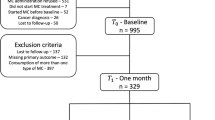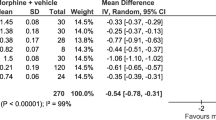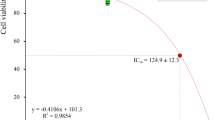Abstract
Despite management with opioids and other pain modifying therapies, neuropathic pain continues to reduce the quality of life and daily functioning in HIV-infected individuals. Cannabinoid receptors in the central and peripheral nervous systems have been shown to modulate pain perception. We conducted a clinical trial to assess the impact of smoked cannabis on neuropathic pain in HIV. This was a phase II, double-blind, placebo-controlled, crossover trial of analgesia with smoked cannabis in HIV-associated distal sensory predominant polyneuropathy (DSPN). Eligible subjects had neuropathic pain refractory to at least two previous analgesic classes; they continued on their prestudy analgesic regimens throughout the trial. Regulatory considerations dictated that subjects smoke under direct observation in a hospital setting. Treatments were placebo and active cannabis ranging in potency between 1 and 8% Δ-9-tetrahydrocannabinol, four times daily for 5 consecutive days during each of 2 treatment weeks, separated by a 2-week washout. The primary outcome was change in pain intensity as measured by the Descriptor Differential Scale (DDS) from a pretreatment baseline to the end of each treatment week. Secondary measures included assessments of mood and daily functioning. Of 127 volunteers screened, 34 eligible subjects enrolled and 28 completed both cannabis and placebo treatments. Among the completers, pain relief was greater with cannabis than placebo (median difference in DDS pain intensity change, 3.3 points, effect size=0.60; p=0.016). The proportions of subjects achieving at least 30% pain relief with cannabis versus placebo were 0.46 (95%CI 0.28, 0.65) and 0.18 (0.03, 0.32). Mood and daily functioning improved to a similar extent during both treatment periods. Although most side effects were mild and self-limited, two subjects experienced treatment-limiting toxicities. Smoked cannabis was generally well tolerated and effective when added to concomitant analgesic therapy in patients with medically refractory pain due to HIV DSPN.
Similar content being viewed by others

Log in or create a free account to read this content
Gain free access to this article, as well as selected content from this journal and more on nature.com
or
References
AACTG (1992). Table for Grading Severity of Adult Adverse Experiences. Division of AIDS, National Institute of Allergy and Infectious Diseases: Rockville, Maryland.
AAN (1991). Nomenclature and research case definitions for neurologic manifestations of human immunodeficiency virus-type 1 (HIV-1) infection. Report of a Working Group of the American Academy of Neurology AIDS Task Force. Neurology 41: 778–785.
Abrams DI, Jay CA, Shade SB, Vizoso H, Reda H, Press S et al (2007). Cannabis in painful HIV-associated sensory neuropathy: a randomized placebo-controlled trial. Neurology 68: 515–521.
Agency for Health Care Policy and Research (1992). Acute Pain Management in Adults: Operative Procedures. Quick Reference Guide for Clinicians AHCPR Pub No. 92-0019. Rockville, MD: Agency for Health Care Policy and Research, Public Health Service, U.S. Department of Health and Human Services.
Backonja MM (2002). Use of anticonvulsants for treatment of neuropathic pain. Neurology 59: S14–S17.
Block RI, Erwin WJ, Farinpour R, Braverman K (1998). Sedative, stimulant, and other subjective effects of marijuana: relationships to smoking techniques. Pharmacol Biochem Behav 59: 405–412.
Calignano A, La Rana G, Giuffrida A, Piomelli D (1998). Control of pain initiation by endogenous cannabinoids. Nature 394: 277–281.
Chapman CR, Syrjala K, Sargur M (1985). Pain as a manifestation of cancer treatment. Semin Oncol Nurs 1: 100–108.
Cornblath DR, Chaudhry V, Carter K, Lee D, Seysedadr M, Miernicki M et al (1999). Total neuropathy score: validation and reliability study. Neurology 53: 1660–1664.
Derogatis LR, Melisaratos N (1983). The Brief Symptom Inventory: an introductory report. Psychol Med 13: 595–605.
Deyo RA (1983). Conservative therapy for low back pain. Distinguishing useful from useless therapy. JAMAama 250: 1057–1062.
Farrar JT, Young Jr JP, LaMoreaux L, Werth JL, Poole RM (2001). Clinical importance of changes in chronic pain intensity measured on an 11-point numerical pain rating scale. Pain 94: 149–158.
Foltin RW, Fischman MW, Byrne MF (1988). Effects of smoked marijuana on food intake and body weight of humans living in a residential laboratory. Appetite 11: 1–14.
Gilson BS, Gilson JS, Bergner M, Bobbit RA, Kressel S, Pollard WE et al (1975). The sickness impact profile. Development of an outcome measure of health care. Am J Public Health 65: 1304–1310.
Gracely RH, Kwilosz DM (1988). The Descriptor Differential Scale: applying psychophysical principles to clinical pain assessment. Pain 35: 279–288.
Gracely RH, McGrath F, Dubner R (1978a). Ratio scales of sensory and affective verbal pain descriptors. Pain 5: 5–18.
Gracely RH, McGrath P, Dubner R (1978b). Validity and sensitivity of ratio scales of sensory and affective verbal pain descriptors: manipulation of affect by diazepam. Pain 5: 19–29.
Hall W, Solowij N (1998). Adverse effects of cannabis. Lancet 352: 1611–1616.
Harder S, Rietbrock S (1997). Concentration-effect relationship of delta-9-tetrahydrocannabiol and prediction of psychotropic effects after smoking marijuana. Int J Clin Pharmacol Ther 35: 155–159.
Kieburtz K, Simpson D, Yiannoutsos C, Max MB, Hall CD, Ellis RJ et al (1998). A randomized trial of amitriptyline and mexiletine for painful neuropathy in HIV infection. AIDS Clinical Trial Group 242 Protocol Team. Neurology 51: 1682–1688.
Lingjaerde O, Ahlfors U, Bech P, Dencker S, Elgen K (1987a). The UKU side effects rating scale. Acta Psychiatr Scand 76: 11–79.
Lingjaerde O, Ahlfors UG, Bech P, Dencker SJ, Elgen K (1987b). The UKU side effect rating scale. A new comprehensive rating scale for psychotropic drugs and a cross-sectional study of side effects in neuroleptic-treated patients. Acta Psychiatr Scand Suppl 334: 1–100.
Little R, Rubin D (2002). Statistical Analysis with Missing Data. Wiley-Interscience: Hoboken, New Jersey.
Mao J, Price DD, Lu J, Keniston L, Mayer DJ (2000). Two distinctive antinociceptive systems in rats with pathological pain. Neurosci Lett 280: 13–16.
Martin BR, Lichtman AH (1998). Cannabinoid transmission and pain perception. Neurobiol Dis 5: 447–461.
Max MB, Lynch SA, Muir J, Shoaf SE, Smoller B, Dubner R (1992). Effects of desipramine, amitriptyline, and fluoxetine on pain in diabetic neuropathy. N Engl J Med 326: 1250–1256.
McNair D, Lorr M, Droppleman L (1992). Profile of Mood States (POMS) Manual. Educational and Industrial Testing Services: San Diego.
Melzack R (1975). The McGill Pain Questionnaire: major properties and scoring methods. Pain 1: 277–299.
Moore TH, Zammit S, Lingford-Hughes A, Barnes TR, Jones PB, Burke M et al (2007). Cannabis use and risk of psychotic or affective mental health outcomes: a systematic review. Lancet 370: 319–328.
Moscucci M, Byrne L, Weintraub M, Cox C (1987). Blinding, unblinding, and the placebo effect: an analysis of patients′ guesses of treatment assignment in a double-blind clinical trial. Clin Pharmacol Ther 41: 259–265.
Rog DJ, Nurmikko TJ, Friede T, Young CA (2005). Randomized, controlled trial of cannabis-based medicine in central pain in multiple sclerosis. Neurology 65: 812–819.
Shlay JC, Chaloner K, Max MB, Flaws B, Reichelderfer P, Wentworth D et al (1998). Acupuncture and amitriptyline for pain due to HIV-related peripheral neuropathy: a randomized controlled trial. Terry Beirn Community Programs for Clinical Research on AIDS. JAMA 280: 1590–1595.
Simpson DM, McArthur JC, Olney R, Clifford D, So Y, Ross D et al (2003). Lamotrigine for HIV-associated painful sensory neuropathies: a placebo-controlled trial. Neurology 60: 1508–1514.
Svendsen KB, Jensen TS, Bach FW (2004). Does the cannabinoid dronabinol reduce central pain in multiple sclerosis? Randomised double blind placebo controlled crossover trial. BMJmj 329: 253.
Tetrault JM, Crothers K, Moore BA, Mehra R, Concato J, Fiellin DA (2007). Effects of marijuana smoking on pulmonary function and respiratory complications: a systematic review. Arch Intern Med 167: 221–228.
Watson SJ, Benson Jr JA, Joy JE (2000). Marijuana and medicine: assessing the science base: a summary of the 1999 Institute of Medicine report. Arch Gen Psychiatry 57: 547–552.
Acknowledgements
This project was supported by Grant C00-SD-104 from the University of California, Center for Medicinal Cannabis Research. We thank Dr Geoffrey Sheean and the staff of the General Clinical Research Center at the University of California, San Diego Medical Center for supporting this project. Statistical analyses were conducted by Florin Vaida.
Author information
Authors and Affiliations
Corresponding author
Additional information
DISCLOSURE
Heather Bentley and Ben Gouaux are employees of the Center for Medicinal Cannabis Research at the University of California, San Diego, the study sponsor. Ms Bentley is Project Manager for the CMCR and assisted the investigator with regulatory issues, oversight/monitoring, and preparation of the manuscript. Mr. Gouaux is a Research Associate with the CMCR and assisted the investigator with regulatory issues, oversight/monitoring, data preparation and analysis, and preparation and submission of the article. The authors declare that over the past 3 years Dr. Atkinson has received compensation from Eli Lilly Pharmaceuticals. The authors declare that they have not received other financial support or compensation in the past 3 years or have any personal financial holdings that could be perceived as constituting a conflict of interest.
Rights and permissions
About this article
Cite this article
Ellis, R., Toperoff, W., Vaida, F. et al. Smoked Medicinal Cannabis for Neuropathic Pain in HIV: A Randomized, Crossover Clinical Trial. Neuropsychopharmacol 34, 672–680 (2009). https://doi.org/10.1038/npp.2008.120
Received:
Revised:
Accepted:
Published:
Issue date:
DOI: https://doi.org/10.1038/npp.2008.120
Keywords
This article is cited by
-
An answered call for aid? Cannabinoid clinical framework for the opioid epidemic
Harm Reduction Journal (2023)
-
The Role of Cannabis, Cannabidiol and Other Cannabinoids in Chronic Pain. The Perspective of Physicians
Journal of Neuroimmune Pharmacology (2022)
-
Interactive Effects of HIV Infection and Cannabis Use on Insula Subregion Functional Connectivity
Journal of Neuroimmune Pharmacology (2022)
-
Cannabinoide zur Therapie chronischer Nervenschmerzen und Spastik
MMW - Fortschritte der Medizin (2022)
-
Pharmacologic and Non-Pharmacologic Treatments for Chronic Pain Used by Patients with Pain, HIV, and Depression
AIDS and Behavior (2022)


